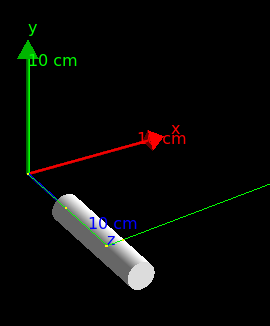Dear Geant4 experts,
I am tryng to simulate a He3-based neutron counter. However, in a test application, Helium-3 neutron cross section appears to be two orders of magnitude lower than expected: ~11 barn versus ~5300 barn.
I have constructed He3 G4Material like so:
//He3 element
G4double atomicMass=3.016*g/mole;
G4Isotope* he3 = new G4Isotope("he3", 2, 3, atomicMass);
G4Element* He3 = new G4Element("He3", "He3", 1);
He3->AddIsotope(he3,100.*perCent);
//He3 gas
G4double pressure = 5*bar,
temperature = 293*kelvin,
molar_constant = CLHEP::Avogadro*CLHEP::k_Boltzmann,
density = (atomicMass*pressure)/(temperature*molar_constant);
G4Material* He3Gas = new G4Material("He3_gas", density, 1, kStateGas, temperature, pressure);
He3Gas->AddElement(He3, 100.*perCent);
Then, I used this material to build a simple detector, a tube along z axis:

The primary particles are set to be neutrons, and are launched with thermal (0.025 eV) energy along z axis.
I have used a modular physics list, where I registered the following physics (which, to my understanding, contain the most accurate low energy neutron processes):
myPhysicsList::myPhysicsList():G4VModularPhysicsList(){
int ver = 0;
this->RegisterPhysics( new G4EmStandardPhysics(ver) );
G4String evaluation("ENDF/BVII.1");
this->RegisterPhysics( new G4HadronElasticPhysicsLEND(ver,evaluation) );
this->RegisterPhysics( new G4HadronPhysicsShieldingLEND(ver) );
this->RegisterPhysics( new G4ThermalNeutrons(ver) );
}
The following log entry appears in physics summary at runtime:
Hadronic Processes for neutron
Process: hadElastic
Model: hElasticCHIPS: 19.5 MeV ---> 100 TeV
Model: LENDElastic: 4 eV ---> 20 MeV
Model: NeutronHPThermalScattering: 0 eV ---> 4 eV
Cr_sctns: NeutronHPThermalScatteringData: 0 eV ---> 4 eV
Cr_sctns: LENDElasitcCrossSection: 0 eV ---> 20 MeV
Cr_sctns: G4NeutronElasticXS: 0 eV ---> 100 TeV
Process: neutronInelastic
Model: FTFP: 3 GeV ---> 100 TeV
Model: BertiniCascade: 19.9 MeV ---> 6 GeV
Model: LENDInela stic: 0 eV ---> 20 MeV
Cr_sctns: LENDInelasitcCrossSection: 0 eV ---> 20 MeV
Cr_sctns: JENDLHEInelasticCrossSection: 0 eV ---> 100 TeV
Cr_sctns: BarashenkovGlauberGribov: 0 eV ---> 100 TeV
Process: nCapture
Model: LENDCapture: 0 eV ---> 20 MeV
Model: nRadCapture: 19.9 MeV ---> 100 TeV
Cr_sctns: LENDCaptureCrossSection: 0 eV ---> 20 MeV
Cr_sctns: G4NeutronCaptureXS: 0 eV ---> 100 TeV
Process: nFission
Model: LENDFission: 0 eV ---> 20 MeV
Model: G4LFission: 19.9 MeV ---> 100 TeV
Cr_sctns: LENDFissionCrossSection: 0 eV ---> 20 MeV
Cr_sctns: GheishaFissionXS: 0 eV ---> 100 TeV
With this, I get ~1200 hits per 2E6 neutrons, which, at 10cm He3 volume at 5bar pressure, equals 11.5 barns.
Is there a cross section not defined? If so, how can I define it?
Any help will be highly appreciated.